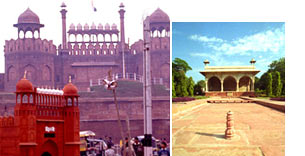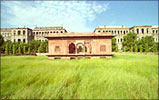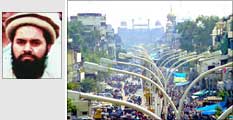The Rediff Special/ Ramesh Menon


Ironic.
It took Pakistani-trained militants to focus attention on the magnificent marvel that is Delhi's Red Fort. Suddenly, people are talking about the majesty of the Lal Qilla, its symbolism as a seat of power, its extraordinary creation.
Extraordinary, it is.
It stands like a sentinel in crowded Old Delhi. It does not look its age; it is over 350 years old. Even in those days it took over a crore of rupees to build. Imagine what it would cost today! The Red Fort is an example of the Mughal zest for architectural totems that they bequeathed to posterity.
The Red Fort extends over an area of 125 acres, and measures 3,200 feet by 1,600 feet. Rising
to a height of over a hundred feet at various spots, its thick red sandstone walls were reinforced at
regular intervals with massive round bastions. A huge moat around the fort made life tough for
invading armies. Its turrets, bastions, thick walls, gates and the intricate work within tell a
glorious tale of rich times gone past. Of history that throbbed with tradition. And ideas. And life.
When Shah Jahan decided to move his capital from Agra to Delhi, the idea of a Red Fort was born. After detailed consultations with his astrologers, work on the fort began in 1638. It took ten years to build. It must have given the Mughal emperor a great sense of achievement when he held his first darbar there in April 1648.
 Tonnes of red sandstone had to be carved and thousands of skilled artisans worked round the clock.
Shah Jahan supervised the Red Fort's general design -- so great was his involvement in the enterprise. Persian brothers Ahmad and Hamid-ul-Ansar supervised the construction day after day.
Tonnes of red sandstone had to be carved and thousands of skilled artisans worked round the clock.
Shah Jahan supervised the Red Fort's general design -- so great was his involvement in the enterprise. Persian brothers Ahmad and Hamid-ul-Ansar supervised the construction day after day.
And look what they achieved.
A wide open space led to the Diwan-i-Am, the hall where the public congregated to petition the Emperor. The hall was 50 feet long and 24 feet wide with a 10 foot open verandah all around. It had 32 sandstone columns plastered with powdered marble.
The Emperor's alcove in the wall was inlaid with precious stones, many of which were looted after the 1857 Mutiny. Its roof had silver and gold inlays, adding to its majesty. On the roof was a couplet: If there be a paradise on earth/It is this, it is this, it is this.
Centrestage was Shah Jahan's fabled Peacock Throne, a gem-encrusted gold chair standing on six massive solid gold feet. The throne got its name from two peacock figures inlaid with sapphires, rubies, emeralds and other precious stones. It was conceived by French jeweller Austin Bordeaux,
and cost the Mughals 150 million francs 350 years ago. The stunning throne stayed at the fort for just a hundred years. The Persian invader, Nadir Shah, took it away as part of his loot. It remains in Teheran today.
In front of the throne was a raised platform from which the wazir handed petitions to the Emperor. In attendance were officers, nobles and others defined by the area they sat in, separated by ropes of gold, silver and red silk. The proceedings were an incantation to glory. On the Emperor's birthday, unparalleled opulence -- costly attire, gold silver and ivory, plumes, parasols, palanquins, caparisoned elephants and horses -- were on display.
 The Rang Mahal -- the palace of colours -- was where the Emperor's wives and mistresses -- hundreds of them -- lived. They existed in opulence, walking through a palace dotted with gilded turrets and decorated by an intricate mosaic of mirrors. Often, they looked into a central pool to watch the reflection of the gold and silver inlays on the ceiling.
The Rang Mahal -- the palace of colours -- was where the Emperor's wives and mistresses -- hundreds of them -- lived. They existed in opulence, walking through a palace dotted with gilded turrets and decorated by an intricate mosaic of mirrors. Often, they looked into a central pool to watch the reflection of the gold and silver inlays on the ceiling.
Using water from the Yamuna river, a canal catered to the hammams, the royal baths that had coloured light filtering in through stained glass windows. The scented water meandered its way through the fort, flowing through pools and fountains. The water was used to keep alive the
fort's gardens, an important element of Mughal life. Credit for the waterworks went to Ali Mardan Khan, once governor of Kandahar for the Shah of Persia.
Shah Jahan is believed to have studied plans of Baghdad while designing his Lal Qilla. Like the great Caliphs, his buildings were aligned north-south to avoid any discordance with the qubla wall, facing Mecca with those of his mosques.
Entrance to the fort was through the imposing Lahori Gate, so called because it faced the direction of Lahore. Entering the Lahori Gate in those times one came across an array of shops at the Chatta
Chowk, selling the finest silks, brocades, enamel, silver, gold. Today, at the same site, all you get are tourist trinkets.
How things have changed
 Now, there are army and police barracks within the palace. The Yamuna no longer flows close to the eastern wall, it is at best a gutter of industrial effluent flowing further away. There are no precious stones or gems that once adorned its marble walls.
Now, there are army and police barracks within the palace. The Yamuna no longer flows close to the eastern wall, it is at best a gutter of industrial effluent flowing further away. There are no precious stones or gems that once adorned its marble walls.
No more music is heard at the Naubhat Khana, where once musicians played five times a day. Last week, the only sound heard were gunshots fired from automatic rifles.
The army controls a major part of the fort. The Archaeological Survey of India is officially in charge of the monument and has a lot of work to do if it wants to restore the Fort to some of its old glory.
The area around the fort is filthy; some of its walls are used as public urinals. Restoration will not be easy; it is something the ASI can ill afford given its present budget. Some national monuments have been taken over by corporations for beautification/restoration. Maybe, the Red Fort will have a corporate group looking after its upkeep soon.
Remember Azhar Masood?
 After the militant maulana was released by the government in exchange for the passengers of IC-814 on New Year's Eve last December, he said he wanted his militants to unfurl Pakistani flags in India. Apart from Kashmir, one of the sites he mentioned was the Red Fort.
After the militant maulana was released by the government in exchange for the passengers of IC-814 on New Year's Eve last December, he said he wanted his militants to unfurl Pakistani flags in India. Apart from Kashmir, one of the sites he mentioned was the Red Fort.
The fort is a symbol of Indian Independence. Pandit Jawaharlal Nehru made his famous speech reflecting his dreams for independent India when he unfurled the tricolour after India became free. Every Independence Day since, the nation's prime minister addresses the nation from the ramparts of the Red Fort.
Sometime ago, the Delhi high court expressed concern over the absence of maintainence at the
Red Fort. The court was hearing public interest litigation filed by the Society for Protection of Heritage and Culture. The society wanted the court to direct the government to remove all the occupants including the army and shopkeepers from the fort and hand the monument over to the ASI.
Is that the solution? It is a question that may have disturbing answers.
The Rediff Specials
Tell us what you think of this feature
